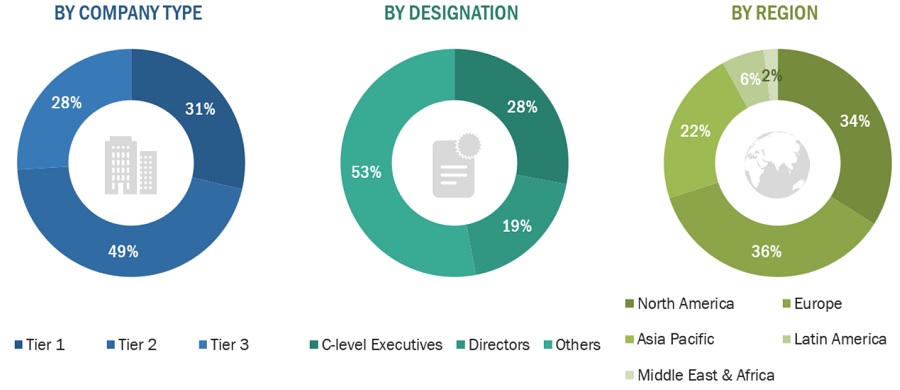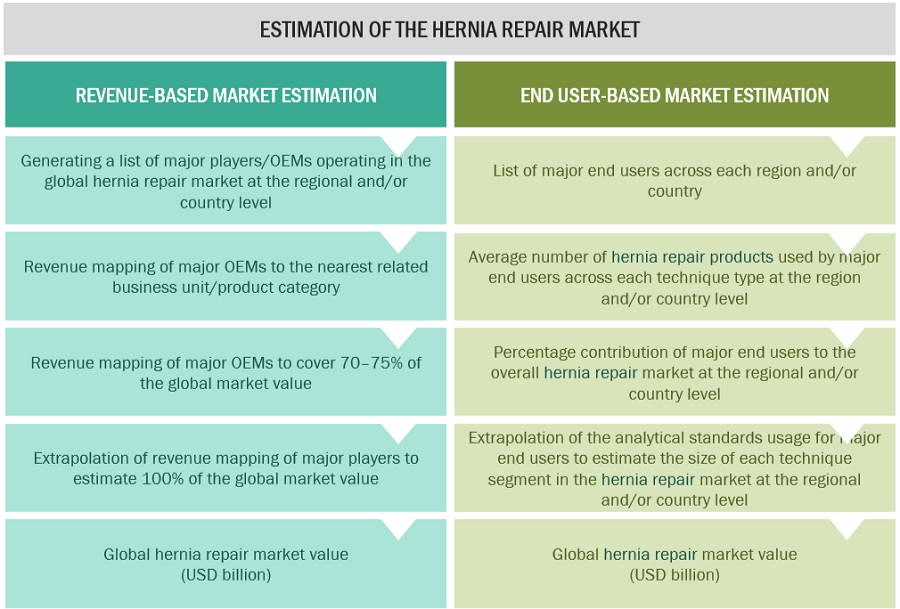This study involved the extensive use of both primary and secondary sources. The research process involved the study of various factors affecting the industry to identify the segmentation types, industry trends, key players, competitive landscape, key market dynamics, and key player strategies.
Secondary Research
The secondary research process involves the widespread use of secondary sources, directories, databases (such as Bloomberg Businessweek, Factiva, and D&B Hoovers), white papers, annual reports, company house documents, investor presentations, and SEC filings of companies. Secondary research was used to identify and collect information useful for the extensive, technical, market-oriented, and commercial study of the hernia repair market. It was also used to obtain important information about the key players and market classification & segmentation according to industry trends to the bottom-most level and key developments related to market and technology perspectives. A database of the key industry leaders was also prepared using secondary research.
Primary Research
In the primary research process, various sources from both the supply and demand sides were interviewed to obtain qualitative and quantitative information for this report. The primary sources from the supply side include industry experts such as CEOs, vice presidents, marketing and sales directors, technology & innovation directors, and related key executives from various key companies and organizations in the hernia repair market. The primary sources from the demand side include OEMs, private and contract testing organizations and service providers, among others. Primary research was conducted to validate the market segmentation, identify key players in the market, and gather insights on key industry trends & key market dynamics.
A breakdown of the primary respondents is provided below:

*Others include sales managers, marketing managers, business development managers, product managers, distributors, and suppliers.
Note: Companies are classified into tiers based on their total revenue. As of 2022, Tier 1 = >USD 2 billion, Tier 2 = USD 50 million to USD 2 billion, and Tier 3 = <USD 50 million.
To know about the assumptions considered for the study, download the pdf brochure
Market Estimation Methodology
In this report, the global hernia repair market size was arrived at by using the revenue share analysis of leading players. For this purpose, key players in the market were identified, and their revenues from the hernia repair products business were determined through various insights gathered during the primary and secondary research phases. Secondary research included the study of the annual and financial reports of the top market players. In contrast, primary research included extensive interviews with key opinion leaders, such as CEOs, directors, and key marketing executives.
Company revenue estimation approach
To calculate the global market value, segmental revenues were calculated based on the revenue mapping of major solution/service providers. This process involved the following steps:
-
Generating a list of major global players operating in the hernia repair market
-
Mapping annual revenues generated by major global players from the hernia repair segment (or nearest reported business unit category)
-
Revenue mapping of key players to cover a major share of the global market as of 2022
-
Extrapolating the global value of the hernia repair industry

To know about the assumptions considered for the study, Request for Free Sample Report
End user-based market estimation
During preliminary secondary research, the total sales revenue of hernia repair was estimated and validated at the regional and country level, triangulated, and validated to estimate the global market value. This process involved the following steps:
-
Generating a list of major customer facilities across each region and country
-
Identifying the average number of hernia repair product supplies used by major customer facilities across each product type at the regional/country level, annually
-
Identifying the percentage contribution of major customer facilities to the overall hernia repair expenditure and usage at the regional/country level, annually
-
Extrapolating the annual usage patterns for various products across major customer facilities to estimate the size of each product segment at the regional/country level, annually

Data Triangulation
After arriving at the overall market size from the market size estimation process explained above, the global hernia repair market was split into segments and subsegments. Data triangulation and market breakdown procedures were employed to complete the overall market engineering process and arrive at the exact statistics for all segments and subsegments. The data was triangulated by studying various factors and trends from both the demand and supply sides. Additionally, the Hernia repair market was validated using both top-down and bottom-up approaches.
Market Definition
Hernia is the protrusion of an internal organ or tissue through a weak portion of a muscle or connective tissue. A hernia mesh is used for sealing this weak portion. This mesh is then kept in place by mesh fixators to avoid displacement and reduce the chances of recurrence.
Key Market Stakeholders
-
Hernia mesh and mesh fixator manufacturers
-
Third-party hernia mesh product suppliers
-
Raw material suppliers
-
Market research and consulting firms
-
Regulatory bodies
-
Venture capitalists
-
Hospitals
Objectives of the Study
-
To define, describe, and forecast the hernia repair market on the basis of on product, clinical indication, surgery type, end user, and region.
-
To provide detailed information regarding the major factors influencing the growth potential of the global hernia repair market (drivers, restraints, opportunities, challenges, and trends).
-
To analyze the micro markets with respect to individual growth trends, future prospects, and contributions to the global hernia repair market.
-
To analyze key growth opportunities in the global hernia repair market for key stakeholders and provide details of the competitive landscape for market leaders.
-
To forecast the size of market segments and/or subsegments with respect to five major regions, namely, North America (the US and Canada), Europe (Germany, the UK, France, Italy, Spain, and Rest of Europe), Asia Pacific (Japan, China, India, Australia, South Korea, and Rest of Asia Pacific), Latin America (Brazil, Mexico, and Rest of Latin America), and the Middle East and Africa (GCC Countries and Rest of MEA).
-
To profile the key players in the global hernia repair market and comprehensively analyze their market shares and core competencies.
-
To track and analyze the competitive developments undertaken in the global hernia repair market, such as agreements, expansions, and & acquisitions.
Available Customizations
With the given market data, MarketsandMarkets offers customizations as per the company’s specific needs. The following customization options are available for the present global hernia repair market report:
Product Analysis
-
Product matrix, which gives a detailed comparison of the product portfolios of the top fifteen companies
Company Information
-
Detailed analysis and profiling of additional market players (up to 10)
Geographic Analysis
-
Further breakdown of the Rest of Europe's hernia repair market into Russia, Belgium, the Netherlands, Switzerland, Austria, Finland, Sweden, Poland, and Portugal among other
-
Further breakdown of the Rest of Asia Pacific hernia repair market into Singapore, Taiwan, New Zealand, Philippines, Malaysia, and other APAC countries
-
Further breakdown of the Rest of the Latin America hernia repair market into Argentina, Chile, Peru, and Colombia, among other



Growth opportunities and latent adjacency in Hernia Repair Market